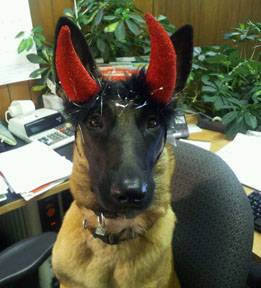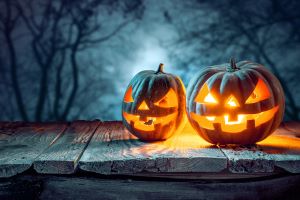Halloween may be a barrel of laughs for people who love to dress up in costumes and party, but most pets aren't quite as fond of the holiday as people are. The doorbell rings far too often and is usually accompanied by loud children; there's enough candy to make a pack of wolves sick; fearful pets can run outside to escape the stress; and the parties tend to be high-energy, noisy affairs. With all of these spooky happenings, even the bravest of pet souls may find Halloween a bit frightening, so it’s important to keep your pet’s peace of mind, health, and safety in mind when planning for the holiday.
Some pets can have increased chronic illness signs (like those with separation anxiety, heart conditions, seizures, intestinal issues, etc.) from all of the noise and activity. Speak with your veterinarian well before Halloween if you have big plans and you know your pet is sensitive to changes in the environment.

Photo by Mary Buck

Photo by Jane Price Warnke
Costumes
Cute internet images may have us all believing that pets and costumes go together like cereal and milk, but your pet may not agree. What may be adorable to us may be just plain miserable for our pets. It's best to keep a few key things in mind if you’re dressing up your pet this year:
- A costume can annoy or frighten some pets when stress is already a little higher than usual. Make certain that any costume (or any clothing at all) fits well and won't make your pet uncomfortable.
- Sometimes elastics are too tight, potentially causing an area to swell and cause pain, or they grab too much hair so that it has the effect of a ponytail pulled painfully tight.
- The bits and pieces of a costume sometimes cause nails to be caught, tripping hazards or allowing someone to step on it.
- If you make or buy a costume, keep it comfy and nonrestrictive.
- Paint should not be used directly on the animal.
- Some dogs will try to eat parts of their costumes, so watch your pets constantly while they are wearing one.
- If the costume involves a mask, make sure your pet’s vision is unrestricted.
Home, Sweet Home
During trick-or-treating or Halloween parties, pets can get frightened and bolt out the open door - an all-too-real risk of getting hit by a car or lost. It's often best to crate nervous or hyper dogs or keep dogs and cats in a closed room, while trick-or-treaters or party-goers are likely to ring the bell. If the activity makes your pet upset, see what your veterinarian thinks about a sedative for the evening. Again, talk to your veterinarian about this well before the holiday.
Outdoor cats are safest inside on this night of bustling activity.
Poisoning can be a concern on Halloween. Cats aren't that interested in candy, but dogs can eat enough of it - and quickly - to get sick enough to need an ER. Emergency rooms see an increase in toxicity cases (especially with chocolate) over Halloween. Gastrointestinal problems are a typical result of eating candy, usually leading to vomiting and diarrhea, but if enough chocolate is in the mix or something contains xylitol you could have some scary issues leading to potential hospitalization, intensive care, and even death. Remind children not to give any candy to the dog, even though it's sweet of them to share their bounty.
Pets may also be spellbound by wrappers (candy, cupcakes, and the like). Make sure to keep all trash out of reach.
Trick-or-Treating with Your Dog
If you take your dog out treat-or-treating with your family, consider using reflective gear. Remember that other dogs and children are wound up with excitement. Keep your dog safe from sudden moves by children, and be aware of other dogs going by with their families.
Costumed humans can set off a territorial or fearful response in a dog, which could result in a bite. If your gut tells you that your dog doesn't have the temperament for this, leave them at home and enjoy quieter activities with them instead.
pumpkins_resized.jpg

Cobwebs, Candles, and Pumpkin Hazards
Candles and jack-o'-lanterns are a fire hazard whether you have pets or not. Dogs and cats may knock over burning candles, or let curiosity get the better of them so that they stick their faces into a jack-o-lantern. Try battery-operated or electric candles to get the same effect without the risk. Strobe lights and loud, moving decorations can be frightening and cause pets to bolt or hide, depending on their temperament. Other decorations, such as fake cobwebs and plastic spiders could create a choking hazard.
While Halloween isn't as noisy or frightening as the Fourth of July - the busiest night of the year for shelters - for pets it's likely in second place as Scariest Holiday of the Year. Keeping your pets away from the spookier parts of the celebration is generally in both your best interests.